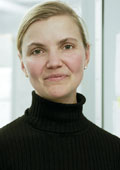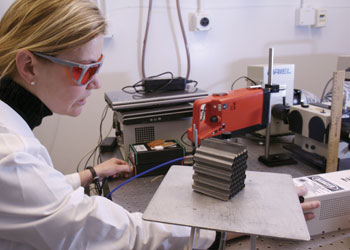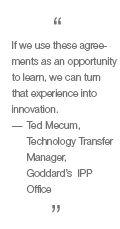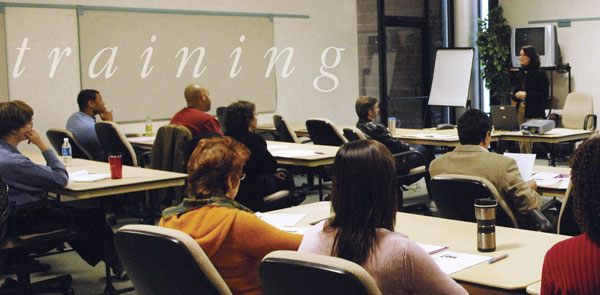|
||||||||||||||||||||||||||||||||||
| volume 6, number 1: WINTER 2008 |
|
|||||||||||||||||||||||||||||||||
|
[Links followed by * open new browser windows.] |
||||||||||||||||||||||||||||||||||
|
Goddard Enters the World of Online Gaming About the initiative The Massively Multi-Player Online (MMO) Learning Game platform is an Agency-wide initiative managed at Goddard and administered by the Learning Technologies Project Office (LTPO). The project is designed to increase interest in and pursuit of science, technology, engineering, and mathematics (STEM) for middle school through higher education students. The IPP Office is facilitating development of an SAA to initiate development and infusion of this new platform for the Agency beginning this year. Agency-wide subject matter experts will be recruited to contribute to the exciting new platform. Goddard’s interest in online gaming Medical and cognitive research indicates that the human brain can be induced to create new neural pathways through simulation. In the same way, NASA hopes to be able to enhance learning through use of “immersive synthetic environments” (ISEs) such as online games. Like suspending disbelief to enjoy the plot of a movie, users can choose to immerse themselves in a virtual world and through that environment train their brain by doing things they might not be able to do in real life. To date, most applications of ISEs have been for entertainment purposes. But Goddard researchers and others believe that the same qualities and features that make ISEs such compelling entertainment also hold tremendous potential for education and collaborative work. “We are currently preparing students for jobs that don’t yet exist, using technologies that haven’t been invented in order to solve problems we don’t even know are problems yet,” noted NASA LTPO’s Daniel Laughlin in a presentation about the new initiative. Those working on the agreement, like Laughlin, believe online gaming will be a key technology in training middle school through higher education students to solve the challenges of the future through highly immersive, collaborative environments. Indeed, the online gaming market is ripe to support Goddard’s MMO initiative. For example, the popular multi-player games World of Warcraft and Second Life alone represent a $19.5 million market. Industry estimates suggest that 20–30 million Americans currently participate in ISEs and, of these, 50% are younger than 19. Current status The LTPO and IPP Office are currently reviewing a significant number of request for information (RFI) submissions in preparation to issue a formal request for proposal (RFP) later this spring. Refer to the NASA MMO home page at for additional details on this exciting new educational platform targeted at the next generation of NASA scientists and engineers. |
||||||||||||||||||||||||||||||||||
|
|
Technology Title: Broadband planar magic-T with low-phase and amplitude imbalance. Inventor: Kongpop U-Yen (Code 555), Edward Wollack (Code 665), and Terence Doiron (Code 555) Case No.: GSC-15470-1
What it is: This invention is a new planar magic-T structure used for combining two microwave signals in-phase and out-of-phase. This four-port device allows signals from two ports to combine in-phase on one port and combine out-of-phase on a second port. The technology features a broadband response with a very low phase and amplitude imbalance. The phase and amplitude error are less than ± 1 degree and 0.25 dB, respectively. The invention consists of two sections: an in-phase combiner and out-of-phase combiner. The construction of these sections reduces sensitivity to fabrication misalignment, and their optimized design produces broadband response with high isolation among ports. What makes it better: The ideal properties of this type of technology can only be obtained at the center of the operating frequency. With prior implementations, isolation between the two ports is often poor and has narrow band response, often due to an unequal phase delay between two input ports and impedance mismatch at the input ports. Prior inventions used several techniques to increase the isolation and the operating bandwidth, but most approaches were complex and expensive to manufacture and also offered lower reliability and yield than Goddard’s planar magic-T. Experimental results on the new magic-T show that it provides excellent performance using more than 70% of operating bandwidth with an average in-band insertion loss of less than 0.6 dB. Using crystallized substrate, the technology can operate in an extremely broad temperature range (0–400 K). It also features very high reliability and low to no maintenance since it has no moving parts. How might it be used: This technology is usable in microwave and millimeter wave frequencies. Therefore, potential applications exist within wireless communication devices, radar, and polarimeter systems. It would also likely be of great interest for low-cost planar hybrids, consumer electronics, and industrial microwave instrumentation. Tech transfer status: Goddard’s Innovative Partnerships Program Office and Office of Patent Council are seeking patent protection for this technology. The IPP Office is also engaging with interested organizations to discuss possible licensing agreements. File your New Technology Reports (NTRs) on eNTRe*. For more information, contact Goddard’s IPP Office (6-5810).
|
|||||||||||||||||||||||||||||||||
Diane “Betsy” Pugel Tell us a bit about your recent research for Goddard. Well, there’s a lot of exciting work that’s been going on. I’m leading the Detector Systems Branch here as a principal investigator on the development end of the Orion heat shield. The project is known as the Crew Exploration Vehicle Thermal Protection System Advanced Development Project* (CEV TPS ADP). The purpose of having an advanced development project is to be able to develop technologies and approaches that advance and support the thermal protection System—the system that protects the astronauts from the harsh thermal environments of re-entry into the Earth’s atmosphere. There are innovative materials proposed for Orion’s TPS, and this calls for innovative approaches to explore material and manufacturing performance. Ames Research Center* is the lead center for this project, and we’re also collaborating with other centers. Unlike the Shuttle’s thermal protection system, Orion will use an ablative TPS. When something ablates, it means that material comes off of it by boiling off, flaking off, or eroding off. Usually, heat is used to drive ablation. For example, when you make a slice of toast in the morning, you’re involved in an ablative process. Successive layers darken with toasting time. Some people like to cook toast for long periods of time to give it that extra dark, crunchy, and charcoaly taste. I’m not one to dispute what people like for breakfast, but ablative thermal protection systems are a bit like making burnt toast. The differences lie in the fact that we are using very big slices of innovative nonbread material and aim for a good understanding of how the toast cooks in different toasters, toasting times, and atmospheres. From a more technical, less culinary aspect, when an ablative TPS, like what was used on Apollo or what may be used for Orion, enters the atmosphere at high velocities, chemical reactions in the TPS material take place that generate gases. Those gases start to move away from the solid material (they boil off) and carry heat away from the astronauts. Not everything boils away though. Some solid material is left behind. It’s usually very much like charcoal, just like burnt toast. It’s called a char layer and serves to insulate the astronauts from superheated gases. What we do at Goddard is inspect the “bread-making” process as well as the untoasted and toasted “bread.” We’re experimenting with different non-destructive evaluation techniques for different stages in the life of the TPS: from its manufacturing, to its integration into the carrier structure, to its exposure to different atmospheric and thermal conditions for different re-entry conditions. We’re looking at the entire lifecycle of a given TPS material.
What methods do you use to test these heat-shield materials? We’re exploring a lot of different techniques. We’re primarily using imaging and spectroscopy techniques in the ultraviolet (UV) and infrared (IR) regions of the electromagnetic spectrum—shining light (UV or IR) on the materials and taking images as well as spectra. We can look at how the degradation proceeds from the surface to the lower layers. We’re also looking at how X-ray, IR, and nuclear magnetic resonance can be used for evaluating different manufacturing stages. So how can you simulate this outside the lab? There are a few ways to prepare the material to simulate re-entry. For example, Ames has an internationally unique facility, the Arc Jet Complex, where they can blast TPS material with heat to simulate what the spacecraft will experience, and they can even change the conditions to simulate different re-entry conditions. Have any of these materials been tested outside the lab? Yes. We’ve looked at the sample return capsule from the cometary probe, Stardust. Stardust was a mission that went out halfway to Jupiter—it’s the only capsule that’s gone out that far and come back. It had an ablative heat shield made of a specific TPS material known as PICA (phenolic impregnated carbon ablator). How close is this work to being mission-ready? We’re coming close to that point now. We’ve been asked to finalize development of an in-field imager/spectrometer approach to evaluate these materials.
Are you doing any UV research with organizations outside NASA? Yes, I’m also working with the Air Force Office of Scientific Research (AFOSR)* in collaboration with Ohio State University (OSU)* and the Air Force Research Laboratory’s Wright Patterson Air Force Base*. About a year and a half ago, our UV group in the Detector Systems Branch* developed the world’s first UV detector that has no filters. The Air Force was interested in advancing this technology from a two-color UV detector to a multi-color detector in a single vertical structure. Why does that matter? Well, typically, you have one camera that’s good for one wavelength. If you want multiple wavelengths, you spread them across an array or have lots of filters. We’re not spreading wavelengths across pixels on an array or using filters. We are developing one camera that works well across this broad range. The idea here is to improve target identification issues associated with currently existing errors with spatial registration, the result of having different pixels, each with different wavelengths, across an array. Goddard’s role is to design and simulate multi-wavelength detector structures that complement the film growth capabilities of OSU and Wright Patterson, two groups at the cutting edge of materials growth. Aside from the usage by the Air Force and DoD, will this research also benefit NASA? Certainly. There’s always a push for advanced detector technology, especially for NASA science missions. Whether its Earth-observing satellites or space-based observations, advancements in the efficiency and reduction in errors associated with measurements using detectors improves measurements that impact Earth science measurements (like aerosols or pollution in the Earth’s atmosphere). Understanding the variables that influence global warming is important and advancements in detector technology advance that understanding. And could the work also be used for commercial applications? Sure. Non-NASA applications include the use of in-house built and commercial cameras for measuring multiple wavelengths from the UV to the IR. We’d also be interested in applying this to things like looking at the behaviors of resins similar to some of the heat-shield materials (bringing our research full circle!), or to measure the time of cure for dental work like fillings. This could also apply to things like composite aircraft technology, which is a growing field. What has been your experience working with the IPP Office? The IPP Office has been proactive in protecting the technologies and looking for other relevant partnerships as well as licensing opportunities. They’ve been great at getting the word out and making sure we go through the patent process. We have two patent applications in process associated with this effort. One is for UV non-destructive inspection techniques and the other is for a two-color UV detector. The IPP Office is leading an assessment to see if a patent will be filed for the two-color detector. These are both areas that are on the rising edge of the slope of innovation, so it’s important that we protect these technologies early on, and the IPP is helping with that process. What do you see as the value of partnering with outside collaborators? No one can do anything completely by themselves. With large, complicated projects, it’s beneficial for us to work together and take advantage of the strengths we all bring to the table. Although one may think that making toast is simple, we need many different cooks in this kitchen. That has been a great thing about both CEV TPS ADP and the AFOSR. I’ve gained access to equipment, knowledge, and people that I would not have had if I was stuck in my own lab. I also have gained a good perspective on how other NASA Centers see the world and how the world outside of NASA sees NASA. Collaborations offer a winning situation for everyone involved.
|
||||||||||||||||||||||||||||||||||
|
|
Goddard Signs New Reimbursable SAA with Genesis A new reimbursable Space Act Agreement (SAA) between Goddard and Genesis Engineering Solutions, Inc.* (Lanham, MD) may ultimately help NASA researchers address contamination issues critical to the success of instruments supporting NASA missions. As part of the agreement, Goddard will test samples of the company’s dry laser cleaning process using Goddard’s state-of-the-art infrared laboratory located in the Optics Branch. Specifically, researchers will determine surface morphology and transmittance/reflectance response using a KLA-Tencor profilometer and a double-beam monochrome, ratio-recording spectrometer. These measurements will be provided to Genesis and will also be of use to NASA, providing additional data for its ongoing cutting-edge research in dry-cleaning technologies that may be used on mission-critical optics instruments. In addition, Goddard will receive reimbursement revenue as part of the agreement. Looking Ahead: Finding Novel Approaches to International Agreements
While international agreements provide a great opportunity to gain global cooperation in achieving NASA’s vision for space exploration, they also present distinct challenges due to their unique requirements compared with domestic agreements. One such requirement is that at least 50% of the product or technology in question be manufactured in the U.S.—which may automatically disqualify some potential agreements that would require technologies built abroad. Because of this, an unfortunate status quo of assuming that “it just can’t be done” often prevents international agreements from even being considered within some organizations, says the IPP Office’s Ted Mecum. “At Goddard’s IPP Office, we don’t want to assume these agreements are just impossible. We want to understand the requirements of the agreement, and very clearly understand the international guidelines. Then we can make intelligent choices about whether the agreement makes sense, and how to make it happen.” As a technology transfer manager, Mecum shepherded one international agreement through to signing in FY07 and is managing a second agreement currently in negotiations. Both agreements involve Goddard’s CHARMS facility, enabling the IPP Office to meet international agreement requirements because the technology in question involved testing at a NASA facility. “Even though the data from the testing was being given to the University of Oxford overseas, the data would also be made available domestically to benefit U.S. organizations, including NASA,” says Mecum. By very clearly understanding the guidelines for international agreements, the IPP Office is making inroads in identifying innovative approaches to international agreements. “We can’t say we’ve solved all the problems yet, because we haven’t done too many international agreements so far,” concedes Mecum. “But with each new agreement we take on, we’re learning the in’s and the out’s so we can apply this learning to the future.” Moving forward, the IPP Office is developing best practices surrounding international agreements—helping to turn challenges into opportunities. “What we don’t want to do is just say, ‘Nope, sorry, can’t do it.’ If we use these agreements as an opportunity to learn, we can turn that experience into innovation.” From Human to Animal Rehabilitation: Enduro’s New License Nets an Equine Prototype
What began as a hinge technology for robots and sounding rockets used in the space program has become a revolutionary rehabilitative device with a growing list of applications—thanks to the strength of the relationship between Goddard’s IPP Office and Enduro Medical Technology. In 2003, Goddard licensed its cable-compliant joint (CCJ) technology to Enduro, which introduced the Secure Ambulation Module (SAM)—a revolutionary device that supports the pelvis and provides compliance that imitates hip-joint movement. The SAM rehabilitative devices have shown remarkable success in both adult and youth patients, notably with soldiers recovering from war injuries at Walter Reed Army Medical Center*. Given this success with human rehabilitation, Enduro engineers engaged in discussions with doctors at nationally renowned veterinary hospitals. Interest among this community was high and convinced Enduro that the CCJ-based technology could also be incorporated into a rehabilitative device designed specifically for horses. Having kept in close contact with the IPP Office, Enduro found a second license agreement to be a natural extension of an already-strong relationship. So in February 2007, Enduro secured a new field-of-use license from Goddard to develop SAM-Equine. The company has developed a prototype of an equine version, and recently announced that it is testing the device on live horses. Currently, horses requiring surgery are anesthetized lying down and brought into and out of surgery while being hung upside down by the legs, putting the animal at risk for further injury. In contrast, Enduro has successfully tested its SAM-Equine prototype on a sedated horse, lifting the animal to a non-weight-bearing position and suspending it in a fully supported manner for up to 45 minutes. Naturally, Enduro personnel are very encouraged by the testing. “This represents a revolutionary change to having a horse brought into and out of surgery in an upright position in a mechanism where the horse is unable to injure itself,” says Enduro President Ken Messier. The company plans to continue testing and minor modifications of the SAM-Equine prototype as it seeks further funding for product development. The company also recently received notice that its technology was selected for the World’s Best Technologies Showcase* being held March 26–27 in Arlington, TX.
|
|||||||||||||||||||||||||||||||||
|
Test Your TTQ* T or F: HQ IPP Seed Fund Proposals & Partnerships While HQ’s Seed Fund call for proposals is still months away, Goddard’s Innovative Partnerships Program (IPP) Office is working to educate innovators now about the ins and outs of Seed Fund proposals and partnerships. This issue’s quiz helps you test your knowledge about the HQ IPP Seed Fund* process. Read on to see how you score, and find out how you can learn more. Decide whether the following HQ IPP Seed Fund-specific statements are true or false.
For more information To learn more about the HQ IPP Seed Fund or to get started forming a partnership in preparation for the call for proposals, contact Goddard’s IPP Office today: 301.286.5810 |
||||||||||||||||||||||||||||||||||
|
Sign Up Now for Tech Transfer Training!
The IPP Office’s successful “Introduction to NASA Goddard Technology Transfer” is an overview course designed to familiarize NASA civil servants and contractors with policies and procedures related to technology transfer. Special emphasis on Goddard-specific practices provides participants with the knowledge and tools they need to work with the IPP Office on many different technology transfer and partnership activities. Why attend technology transfer training? Technology transfer training is vital to helping you understand key concepts that can benefit both you and Goddard. In the training, you will learn:
2008 Tech Transfer Overview Course dates have been scheduled-—giving you plenty of time to sign up well in advance. March 27: Goddard Building 1, Room E100D June 26: Goddard Building 1, Room E100E September 18: Goddard Building 1, Room E100D December 2: Location TBA To register: Civil servants can register online*. Contractors can register by contacting Dale Hithon (301-286-2691), who can also provide further information about the training |
||||||||||||||||||||||||||||||||||
NASA Inventions and Contributions Board Awards The following awards were issued by ICB* during the first quarter of FY08. To be eligible for any of these awards, innovations must have a New Technology Report on file. The IPP Office can help with the award application process. For more information, go to the Awards page in the “News and Events” section of the IPP Office’s Web site. For more information on filing a New Technology Report:
Tech Briefs Awards
Software Release Awards
For more details, contact Dale Hithon or visit NASA Awards.
|
||||||||||||||||||||||||||||||||||
|
Goddard Co-Sponsors First COMET Workshop In cooperation with the United States Air Force Office of Responsive Spacecraft (ORS)* and The Aerospace Corporation*, Goddard sponsored the first Composite Material Engineering Technology (COMET)* for Spacecraft Applications Workshop October 16–17, 2007 at the Johns Hopkins University’s Applied Physics Laboratory* in Laurel, MD. Christopher L. Moore, NASA Headquarters’ Program Executive for Technology Development for the Exploration Systems Mission Directorate introduced the workshop, while Goddard’s Mechanical Systems Division Chief, Ken Hinkle, presented Goddard’s composite technology thrust initiative. The workshop brought together leading experts in the use of composites materials in aerospace applications to present and discuss the state of the art and technological advances in an open forum. The two-day workshop included programmatic technical overviews from relevant NASA missions and approximately 20 presentations from the composite materials engineering for aerospace applications community, including a presentation by IPP Office representative Nannette Stangle-Castor, “Adding Value Inside and Outside NASA.” The IPP Office used this exciting opportunity to introduce the IPP Office’s services, highlight the capabilities of Goddard’s composites branch, and encourage potential partners to begin discussions with the Office. As a successful result of the workshop, Goddard’s composites group submitted and received approval for a collaborative project involving the Air Force Research Laboratory* and The Aerospace Corporation.
IPP Office Attends ESMD Technology Exchange Conference In November 2007, the Exploration Systems Mission Directorate (ESMD) hosted its first Technology Exchange Conference in Galveston, TX. The conference was attended by more than 300 participants, including representatives from Goddard’s IPP Office. Other attendees included government, industry, national laboratories, and academic representatives. The event was a valuable forum for NASA Centers and outside organizations to understand current and future ESMD program needs. The conference was also designed to facilitate the exchange of information between NASA’s technology customers and potential technology providers, as well as to promote dialogue for potential collaborations and identify key challenges and potential solutions for sustained and affordable space exploration. As a result of attending this conference, IPP representatives have shared the needs of the Constellation Program with Goddard technology management in order to strategically position Goddard for future work. In addition, the event helped the IPP Office facilitate the beginning of discussions between the composites group at Goddard and a leading commercial company to partner on a mutually beneficial project
IPP Networks and Promotes Goddard Technologies at Many Other Events
IPP Office representatives networked with potential partners and colleagues to promote Goddard technologies at many events in Q1 of FY08.
|
||||||||||||||||||||||||||||||||||
|
|
||||||||||||||||||||||||||||||||||
|
You can report new project technologies through the online eNTRe* system. |
||||||||||||||||||||||||||||||||||
|
Chief: Nona Cheeks Goddard Tech Transfer News is the quarterly magazine of the Innovative Partnerships Program Office (Code 504) at NASA Goddard Space Flight Center in Greenbelt, Maryland. This magazine seeks to inform and educate civil servant and contractor personnel at Goddard*, as well as at Wallops Flight Facility* and the Independent Verification and Validation (IV&V) Facility*, about actively participating in achieving NASA’s technology transfer goals:
Please send suggestions or feedback about Goddard Tech Transfer News to the editor or go to our online feedback system*. |
||||||||||||||||||||||||||||||||||
|
||||||||||||||||||||||||||||||||||





















